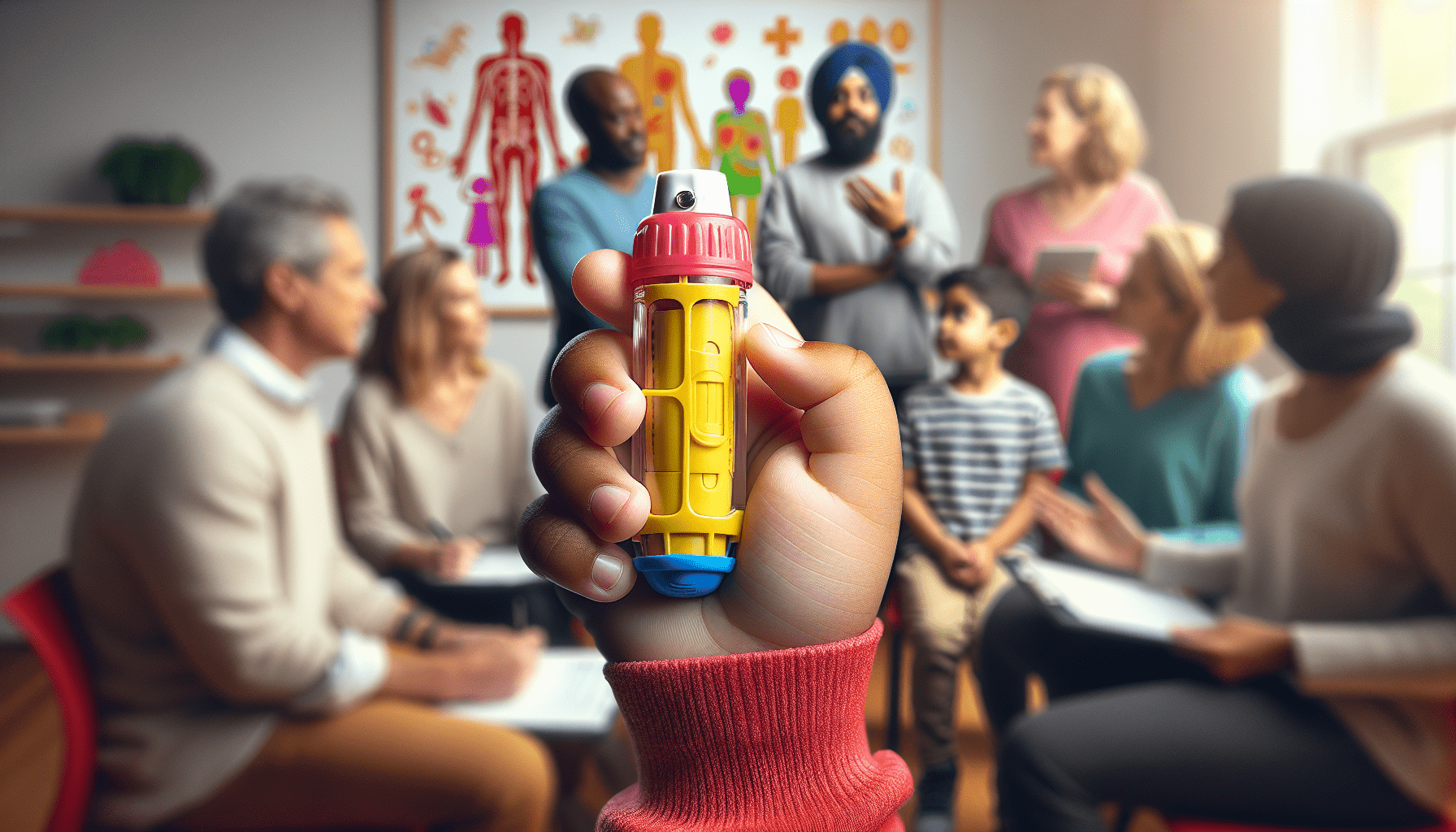In the article “Best Ways to Educate Your Child’s Caregivers About Their Allergies,” you will discover how to effectively communicate crucial information about your child’s allergies to those who watch over them. By following these practical tips, you’ll ensure your child’s caregivers are well-prepared and confident in managing any potential allergic reactions, offering you peace of mind and safeguarding your child’s well-being. Have you ever found yourself anxious or worried about leaving your child in the care of others because of their allergies? You’re definitely not alone. Many parents face this dilemma, often questioning if the caregivers understand the severity and management of their child’s allergies. But worry not! There are ways to ease your anxiety and ensure your child’s caregivers are well-informed and capable of handling any allergy-related situations that may arise.
Understanding Your Child’s Allergies
Before we dive into educating caregivers, it’s essential to make sure you have a firm grasp of your child’s specific allergies. Knowing the ins and outs will help you communicate effectively and confidently.
Types of Allergies
Understanding the types of allergies your child has is crucial for conveying accurate information. Allergies can generally be categorized into:
- Food allergies: Common ones include nuts, dairy, soy, wheat, eggs, fish, and shellfish.
- Environmental allergies: Pollen, dust mites, pet dander, mold, and more.
- Drug allergies: Reactions to certain medications, ranging from mild to severe.
- Insect allergies: Reactions to stings or bites from insects like bees or ants.
- Contact allergies: Reactions to things like latex or certain plants.
Severity of Allergies
Not all allergies are created equal. Some are mild and cause only minor discomfort, while others can be life-threatening. It’s important to categorize them:
| Severity | Symptoms |
|---|---|
| Mild | Sneezing, rashes, itching, mild discomfort |
| Moderate | Hives, swelling, gastrointestinal issues, respiratory distress |
| Severe | Anaphylaxis – difficulty breathing, severe swelling, drop in blood pressure |
Knowing the severity will help you prioritize what information to focus on when educating caregivers.
Preparing Educational Materials
Once you understand your child’s allergies thoroughly, the next step is assembling the necessary materials for education. This includes written documentation, emergency plans, and easy-to-understand visual aids.
Written Documentation
Start by compiling a comprehensive document that covers everything a caregiver needs to know. Here’s a list of what to include:
- Overview: A brief overview of your child’s allergies.
- Allergens: List specific allergens to avoid.
- Symptoms: Detail the symptoms associated with each allergy.
- Action Plan: Step-by-step guide on what to do in case of an allergic reaction.
- Medication: Information on medications, their dosages, and how to administer them.
Consider this a ‘Cheat Sheet’ for caregivers. Keeping it clear and concise can make a world of difference.
Emergency Action Plan
An emergency action plan (EAP) is a must-have. This document should be prominently displayed and easily accessible. It needs to include:
- Immediate Actions: What to do first if a reaction occurs.
- Medication Administration: Instructions for administering Epinephrine or other emergency medications.
- Follow-Up: Steps to take after administering initial treatment, including when to call 911.
- Contact Information: Your contact info and a list of emergency contacts.
Visual Aids
For those who might be more visual learners, consider creating posters or cards with pictorial instructions. Pictures of symptoms can help caregivers recognize them more quickly. Also, a diagram of the steps to use an epinephrine auto-injector can be incredibly helpful.

Training Sessions
Once you’ve prepared the materials, the next step is to conduct training sessions for the caregivers. These can take many forms, from formal meetings to casual, hands-on practice sessions.
Formal Meetings
A structured, formal meeting is one of the best ways to ensure all caregivers are on the same page. During these meetings, you can go over all documentation, answer questions, and provide hands-on demonstrations.
Hands-On Practice
Nothing beats the effectiveness of hands-on practice. Consider simulating scenarios where caregivers can role-play administering medication or following through on your child’s emergency action plan. This will boost their confidence and readiness.
Q&A Sessions
Encourage open dialogue by setting aside time specifically for questions and answers. This will help clear up any uncertainties and reinforce what’s been taught.
Continuous Education and Updates
Education doesn’t stop after the initial training session. It’s important to keep caregivers updated on any changes or new information regarding your child’s allergies.
Regular Updates
Whenever there’s a change—be it a new medication, a change in the severity of a reaction, or a new allergy altogether—make sure to update all educational materials and inform caregivers right away.
Regular Check-Ins
Schedule regular check-ins to ensure everyone is still comfortable with the procedures and feels confident in their ability to manage your child’s allergies. This could be an informal chat or a more structured review session.
New Caregivers
Whenever a new caregiver comes into the picture, give them the same comprehensive training and materials as you did with the initial group. Consistency is key.

Creating a Safe Environment
Ensuring that your child’s environment is safe is as important as educating caregivers. This helps minimize the chances of exposure to allergens and provides everyone with a sense of security.
Home Environment
If the caregiving happens at your home, you have more control over the environment. Make sure to:
- Label Foods: Clearly mark which foods are safe and which are not.
- Creating Allergy-Free Zones: Areas in the home that are completely free of allergens.
- Storing Medications: In an easy-to-access, yet safe location.
Outside the Home
For places like daycare centers, schools, or even the homes of family members and friends, you’ll need to take extra steps. Provide these venues with detailed instructions and visit them to ensure safety measures are being followed.
Relaying Information
Make sure everyone involved in your child’s care knows where the emergency medication is kept and how to reach you in case anything goes awry.
Open Communication
Creating an open, ongoing dialogue ensures that the lines of communication are always open. This way, if a caregiver has concerns or questions, they’ll feel comfortable coming to you immediately.
Establish Trust
Trust is foundational in any caregiving relationship. Make sure to show your appreciation for their efforts and make it clear you’re open to any questions or concerns they might have.
Encourage Feedback
Encouragement can go a long way. Let caregivers know that their feedback is valuable. They might have observations or suggestions that you haven’t considered, which could be beneficial for improving the overall safety and care of your child.
Leveraging Technology
In our tech-savvy world, there are numerous apps and resources that can assist in managing your child’s allergies. Utilizing these tools can make everyone’s job easier.
Allergy Management Apps
There are various apps designed to help manage allergies. Some popular ones include:
- AllergyEats: Helps find allergy-friendly restaurants.
- Spokin: Provides personalized food and product recommendations.
- EpiPen: An app for managing your EpiPen with instructions and reminders.
Shared Resources
Consider using shared digital documents like Google Docs or Dropbox where you can store and update all essential information, making it accessible to everyone at a moment’s notice.
Alert Systems
There are even wearable devices or smart alert systems that you can set up to monitor your child. These devices can send alerts directly to your phone and to the caretaker if there’s any deviation in your child’s normal health.
Legal and Ethical Considerations
Beyond education, you may run into legal and ethical considerations, especially if your child attends school or daycare.
Medical Forms
Ensure all necessary medical forms are filled out and submitted to relevant authorities. This includes the emergency action plan, medications, and any doctor’s notes required.
Ethical Responsibility
All caregivers have an ethical responsibility to keep your child safe. Ensure they understand the gravity of this responsibility and any potential repercussions of neglecting it.
School Policies
Familiarize yourself with your child’s school or daycare policies regarding allergies. This way, you can be sure they align with your expectations and your child’s needs.
Emergency Contact List
It’s crucial to have a comprehensive emergency contact list always available.
Who to Include
The list should include:
- Primary Contacts: You and perhaps another family member or close friend.
- Healthcare Providers: The child’s allergy specialist and pediatrician.
- Local Emergency Services: Nearest hospital, local ambulance services.
- Backup Caregivers: Neighbors or friends who live nearby and understand your child’s needs.
Keeping It Accessible
Make sure this list is easily accessible to all caregivers. It should be in both digital form (shared via email or a shared file) and in printed form, so there’s no confusion or delay during an emergency.
Behavior and Emotional Support
Children with allergies often feel anxious or different because of their condition. Supporting them emotionally is as important as managing their physical health.
Communicate with Your Child
Teach your child to communicate their allergies to others confidently. Role-play scenarios where they might need to explain their allergies or refuse food that could be harmful.
Build Confidence
Assure your child that having allergies doesn’t make them different in a negative way. Emphasize their strengths and help them understand that being careful is part of taking care of their health.
Preparing for Social Situations
Allergy education extends beyond daily care situations; it also involves preparing for social scenarios like birthday parties, playdates, and family gatherings.
Birthday Parties and Social Events
Reach out to hosts in advance to discuss your child’s allergies. Offer to provide safe snacks and treats, ensuring there’s something your child can enjoy without risking their health.
Playdates
Speak to other parents about your child’s allergies before playdates. Make sure they understand the importance of adhering to the guidelines you provide.
Family Gatherings
Family members may already be somewhat familiar with your child’s allergies, but a refresher can never hurt. Make sure everyone is on the same page to prevent accidental exposure.
Conclusion: Empowering Caregivers
At the end of the day, your goal is to empower your child’s caregivers, making them feel confident and capable of managing your child’s allergies. By providing comprehensive, easy-to-understand resources and maintaining open lines of communication, you’ll help ensure that everyone involved feels prepared to keep your child safe and healthy.
Remember that you’re all part of a team with one goal in mind: the well-being of your child. With careful planning, regular updates, and sincere communication, you can create a support system that makes you feel comfortable and your child feel safe, no matter who’s in charge.
